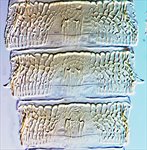Generic diagnosis
Female macropterous. Head with irregular rugose sculpture, projecting in front of eyes; occipital ridge absent, cheeks constricted at base; postocular setae obscured by reticulation; maxillary palps 2-segmented. Antennae 8-segmented, segment I without paired dorso-apical setae; III and IV each with a stout simple or forked sense cone, IV also with a slender simple sense cone. Pronotum rugose, no long setae. Mesonotum reticulate, with median longitudinal division; anteromedian campaniform sensilla absent. Metanotum rugose medially with triangle, median setae close to posterior margin, campaniform sensilla present. Fore wing anterior margin without fringe cilia, costa almost fused with first vein; first and second veins with setae minute, first vein with scattered setae, second vein with setal row complete; posterior margin fringe cilia straight; clavus with two veinal but no discal setae. Prosternal ferna divided; basantra membranous and without setae; mesosternal endofurca without spinula, metasternal endofurca lyre-shaped not reaching mesosternum. Legs reticulate, tarsi 1-segmented. Tergites with entire craspedum, rugose laterally; VIII posterior margin without comb; IX with anterior campaniform sensilla present; X median split complete. Sternites covered with reticulation, craspedum entire; II–VII with three pairs of posteromarginal setae; VII with two additional small setae.
Male sternites III–VII with median circular pore plate.
Biological data
The members of this genus all feed on leaves, but usually not on the tissues of young leaves.
Distribution data
An Old World genus with two species from Africa and three from the Asian tropics, but the record of africanus from Taiwan is possibly a misidentification of concoloratus from Yunnan. These two species are unusual within the genus in having forked sense cones on ntennal segments III and IV, whereas these are simple in both cruentatus and pulchellus. .
Nomenclatural data
Rhipiphorothrips Morgan, 1913: 17. Type species Rhipiphorothrips pulchellus Morgan, 1913, by monotypy.
There are five species recognised in this genus, of which four are recorded from southern China:
africanus Wilson, 1975: 220.
concoloratus Zhang & Tong, 1993: 52.
cruentatus Hood, 1919: 94.
pulchellus Morgan, 1913: 17.
Relationship data
Thripidae sub-family Panchaetothripinae: this group is represented widely around the world, particularly in tropical areas, and comprises about 40 genera. Possibly related to Heliothrips, the species of this genus are distinguished by the projection of the head in front of the eyes, and the lateral prolongation of the mesothorax around the posterior angles of the pronotum. The two most widespread species in Asia have the antennal sense cones simple and stout, but africanus and concoloratus have these sense cones forked.
References
Mound LA, Marullo R & Trueman JWH (2001) The greenhouse thrips, Heliothrips haemorrhoidalis, and its generic relationships within the sub-family Panchaetothripinae (Thysanoptera; Thripidae). Journal of Insect Systematics and Evolution 32: 1–12.
ThripsWiki (2020) ThripsWiki - providing information on the World's thrips. <http://thrips.info/wiki/Main_Page>


